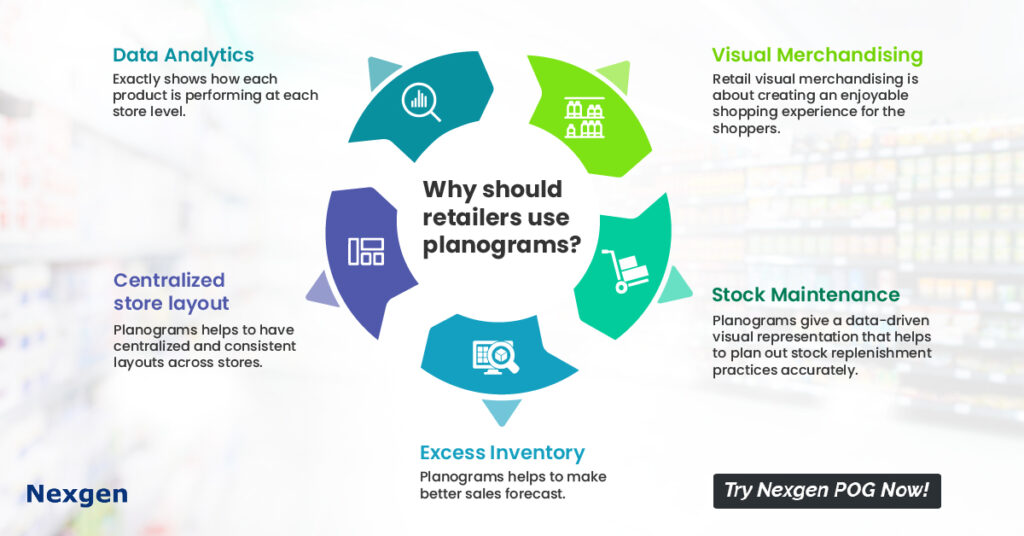
A planogram is more than just a tool; it's a strategy for success. It visually maps product placement to maximize sales, optimize space, and enhance the customer shopping experience.
A planogram ensures efficient shelf utilization and improves store operations. It helps retailers display products in the most attractive and strategic way to draw customer attention and increase revenue.
Planograms are vital for businesses aiming to stand out in competitive retail markets. Let’s explore their purpose, concept, and benefits in detail.
What is the purpose of a planogram?

A store without a planogram risks chaos. Imagine customers struggling to find products or employees constantly rearranging shelves. The purpose of a planogram is to prevent this and ensure an organized, efficient, and customer-friendly environment.
Planograms guide retailers on how to best allocate shelf space for products. They prioritize products based on sales potential, customer preferences, and store goals, ensuring that every inch of shelf space contributes to profitability.
Planograms serve as blueprints for product placement. They eliminate guesswork, offering clear instructions on where each item should go. This precision leads to several advantages:
How planograms save space
Shelf space is finite. Planograms make sure every product gets its fair share. High-demand items often get prime real estate—eye-level shelves where customers are more likely to notice them how planograms optimize shelf space1. Lower-demand products are strategically placed elsewhere, ensuring a balanced display.
| Product Placement | Example |
|---|---|
| Eye-Level | High-margin snacks or candies |
| Lower Shelves | Bulkier or family-sized items |
| End Caps | Seasonal promotions |
By assigning specific spaces, retailers can plan inventory better, restock efficiently, and avoid overcrowding how planograms improve inventory management2. This leads to a smoother shopping experience for customers and higher operational efficiency for staff.
What is the concept of planogram?

A planogram isn’t just a diagram—it’s a visual representation of strategy what is a planogram3. Its core idea is simple: place the right products, in the right place, at the right time, for maximum impact.
The concept of a planogram revolves around customer behavior. It uses data-driven insights to arrange products where customers are most likely to notice and purchase them data-driven insights for planograms4.
Retailers design planograms by analyzing sales trends, customer preferences, and even psychological triggers. For instance:
Psychological Factors in Planograms
- Color: Brightly colored packaging grabs attention.
- Size: Larger products may occupy prominent positions to project value.
- Position: Items placed at eye level tend to sell more due to easy visibility.
| Factors | Impact on Sales |
|---|---|
| Bright Colors | Attract impulse buyers |
| Eye-Level Placement | Drives visibility and quick picks |
| Logical Grouping | Encourages complementary purchases |
For example, placing chips next to dips encourages shoppers to buy both psychological triggers in planograms5. The concept ensures every placement decision leads to higher sales and a seamless shopping journey.
What makes a good planogram?

Not all planograms are created equal. A good planogram is one that drives sales, reflects customer needs, and is easy to implement features of a good planogram6.
A well-designed planogram balances aesthetics and functionality. It highlights best-selling products while maintaining a logical flow for easy navigation.
To create an effective planogram, consider these factors:
Key Features of a Good Planogram
- Clarity: It must be easy for employees to understand and implement.
- Flexibility: It should allow adjustments for seasonal or promotional changes.
- Data-Driven: It should reflect insights from past sales data.
- Customer-Focused: It must align with how customers browse and buy.
Retailers also test and refine their planograms. For instance, if a product isn’t selling, it may need to be moved to a better location. Continuous monitoring ensures the planogram stays effective over time.
Which of the following is a benefit of using planograms?

Planograms do more than just organize shelves—they offer measurable business advantages. Retailers who use them often see immediate improvements in sales and operations benefits of using planograms7.
The benefits of planograms include better inventory management, increased sales, and enhanced customer satisfaction. They also reduce labor costs by simplifying shelf stocking processes.
Here’s how planograms drive tangible results:
Inventory Management Made Easy
Planograms create a clear visual for product placement. Employees can spot gaps or overstock issues at a glance. This reduces the risk of running out of popular items or wasting shelf space on slow movers.
Enhanced Customer Experience
When products are logically arranged, customers find what they need quickly. This encourages repeat visits. For example, grouping related items (e.g., pasta next to sauces) simplifies shopping and boosts complementary sales.
Increased Sales
Strategic placement of high-margin products or promotional items ensures they get noticed. Retailers can also rotate layouts based on seasonal trends to maximize revenue.
| Benefit | Impact |
|---|---|
| Better Inventory Control | Reduced stockouts and overstocking |
| Customer-Friendly Layout | Increased customer loyalty |
| Strategic Placement | Higher sales of key products |
Conclusion
Planograms are essential tools for modern retail. They optimize shelf space, enhance customer experiences, and drive business growth. Their strategic use benefits both retailers and shoppers alike.
-
Learn how planograms ensure efficient use of limited shelf space. ↩
-
Discover how planograms simplify stock management and restocking processes. ↩
-
Understand the concept and strategic importance of planograms. ↩
-
Explore how sales trends and customer behavior influence planogram design. ↩
-
Learn how planograms leverage customer psychology to drive sales. ↩
-
Discover the essential qualities that make a planogram effective. ↩
-
Understand how planograms boost sales, inventory management, and customer satisfaction. ↩

